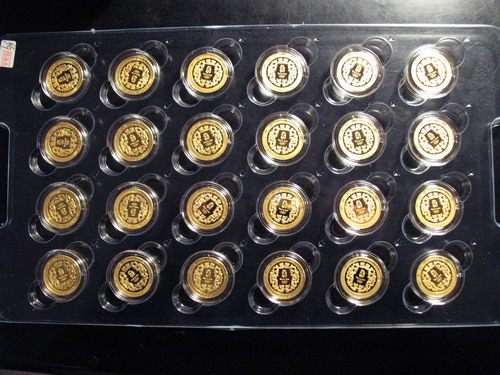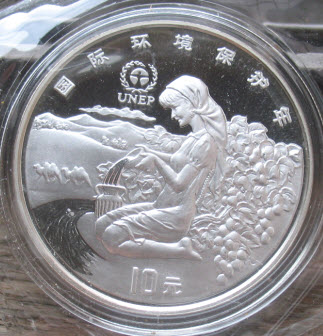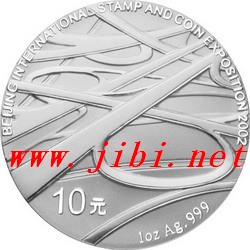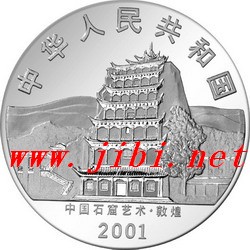By Huang Ruiyong
Source: http://bbs.jibi.net/dispbbs.asp?boardid=212&Id=244038
First and foremost, judging from the trend and direction of coin collection, OMP and COAs are not of utmost importance to collectors. Let's see how foreign collectors view this
issue. Milled coins made their first appearance in Europe and America, and were
introduced to China only in the late Qing Dynasty. In the collection and
research of milled coins, European and American collectors are far more
advanced than we are. In Europe and in the US, collectors, connoisseurs and professional grading services treat
lightly the OMP and COA of a coin. Instead the condition of the coin is the
focus. A coin in excellent condition is hotly pursued even if it is raw. A coin
in OMP with a COA will not sell at a higher price than a raw coin in the same
condition.
Secondly, OMP of precious metal coins from the
PRC is limited to certain historical periods. Many early coins did not have the
so called OMP packaging, such as the 30th Anniversary of the
Founding of the PRC, the proof version of Year of the Child, the first set of the Bronze Age gold coins, and the International Year
of Peace. Many BU Panda gold coins and large size coins and medals were simply
sealed in a plastic pouch, such as the 1984 12oz gold Panda, the 1985 and 1986
Hong Kong Expo silver medals, and the 1986 Sun Yat-Sen 5oz silver coin. The
so-called OMP came in fashion after the China
Gold Coin Co. was founded in 1987. Our definition of OMP here is the coin
sealed in a round capsule, which is in turn sealed in a plastic pouch. In recent years, many new commemorative coins
followed the international trend, with a round capsule to protect the raw coin
and no plastic pouches. A fixed number of coins are then placed directly into a
rectangular or round coin plate, shown in pictures 1 and 2. We can conclude
that the so-called OMP may well be the phenomenon for some specific periods in the history of precious metal coins and medals
from the PRC. Nobody can tell whether coins released in the future will be
sealed in plastic pouches.
Picture 1

Picture 2

Thirdly, does OMP really make sense? Many take
the following as the advantage of OMP:
1. If in OMP, the coin has never been cleaned.
2. The vacuumed pouch can protect the coin from sulfuration or
oxidation.
3. Coins in OMP must be in perfect condition.
Are these true facts? Not necessarily! First,
collectors or coin dealers can send early-year coins dipped in cleaning
solutions to the mint for re-sealing if they know the mint well. That's why we
find brand new external packaging on many coins issued
years ago. Next, the plastic film used to seal coins is often made of polyethylene, PVC or polypropylene. Of these materials, polyethylene and polypropylene are
harmless, but PVC is harmful. That means that coins sealed in PVC should have
the plastic pouch removed. Besides, plastic pouches do not stay vacuumed or provide moisture protection. We often see
early coins (such as lunars and Unicorns) with small bags of desiccant in the
pouch, proving that the plastic pouch alone cannot isolate the coin from
external air.
But the discussion above has not touched on the most crucial point. We may all have
discovered that precious metal coins released in the last few years have a good
fit with the round plastic capsule, and are well sealed. In the early years, however, the capsule did not close tightly. As a result, when we pick up the coin by holding the cover of the capsule, the bottom of the capsule may fall out with the coin. If there are no cushions or
carpets underneath, it will be a disaster. Due to the loose fit of the cover of the plastic capsule, and also to the poor design of the capsules, many gem coins with high relief were
damaged. Most frequent problems include the following: 1. Head rub, most often
seen on 1987 and 1988 platinum Pandas, the 1989 palladium Panda, 1992 and 1993 1oz
proof silver Pandas, 1994 5oz and 12oz Children at Play silver coins, 1990
Munich Expo gold and silver medals; 2. Nose rub, most often seen on 1990 BU and
proof silver Pandas, 1993 1oz Sun Yat-Sen gold coin, 1993 Song Qingling silver
coin (with signature); 3. Shoulder rub: 1989 Founding of the PRC gold coin; 4.
Belly rub: 1984 Olympics Volleyball mirror and matte versions; 5. Bust rub:
1991 25th Olympics Women Ping Pong Players. Many rare coins are not
in good condition even though they are in OMP. The main culprit is the poor fit
of the plastic capsule, which allows constant rubbing
and bumping during transportation and results in serious damage of the coins.
Due to the subpar quality of the plastic
capsules of our country, the capsules may have been shattered during frequent
movement or long distance transportation, even if the coin is still in OMP.
When this happens, the debris of the plastic capsule may roll around on the
mirror field of the coin when we pick them up. If we run into coins in this
condition, OMP should be removed without any
hesitation. Otherwise the debris may scratch the mirror field of the coin.
The funny thing is that when we examine OMP
coins from the Shanghai Mint or Shenyang Mint, we run into surprises from time
to time, among which are seed shells or
hair. Please see Picture 3.
Picture 3

Speaking from the perspective of a coin collector, many of
the coins from earlier years do not have good plastic capsules, which need to be replaced by more professional plastic capsules or
pouches, like in Picture 4. Generally speaking, capsules from Europe and the US
have very good fit, especially those with black rings. It takes some effort to
open the capsule once it is closed tightly. This will reduce the risk of the
coin rubbing the plastic capsule during movement.
Picture 4

Next, we will talk about COAs. The so-called
COAs for precious metal coins are nothing but a piece of paper with descriptions. As Mr. Ge Zukang said, a fake COA with a genuine coin does not falsify
the coin, while a genuine COA with a fake coin does not turn the coin into a genuine one. Early COAs came in various forms. Even the
paper used for printing COAs fell into different categories: Linen finished paper, card paper, coated
paper… Only recently did COAs start to be printed on banknote paper with water marks.
Many coins were distributed by foreign
companies, and the so called COAs were not printed by the People’s Bank of
China. Instead, they were printed by foreign distributors,
such as those for all the gold, silver and platinum Unicorn coins, Taiwan
Scenery gold coin Set 1… The domestic COAs for such coins currently on the market were printed by Chinese dealers later on, but have been
accepted by all. Besides, COAs for many coins were discarded by distributors in
their business in early years, such as those for the Year of the Child silver and gold coins, the 1982 Soccer gold and silver coins, and the UN Decade of Women silver coin. We have gotten used to collecting these coins without COAs. As for the 8 gram lunar
coins, the 1986 27 gram Sun Yat-Sen silver coin, the 1/2oz Three Kingdoms gold
coins Set 1, 5oz gold Qi Baishi, the 1988 Woman Sword Dancer gold coin, their
fake COAs are as good the genuine ones. Moreover, the fake COAs for the 12oz
gold Snake, 1oz gold Dragon and the 1989 1oz silver Snake are better made than the genuine COAs. If the collector comes across the fake ones first
and gains a false impression, he or she would throw out the genuine COAS later on. In this light, if undue emphasis is placed on
the so-called COAs, those who are away from the Lugong and Madian Markets will
get hurt most, because they do not have easy access to the physical coins, let alone catching the slight difference
between fake and genuine COAs.
As King Chan once said, it would be more desirable
to collect COAs as documents related to coins. COAs can still capture the heart
of collectors for now primarily because the gold and silver coin and medal
market is still a buyer’s market or a semi-buyer’s
market. The COA is sometimes used as a tool for bargaining. Imagine that in the
near future, if the precious metal coin market changes completely into a
seller’s market, the COA will totally lose its function as a bargaining chip
when a coin in perfect condition is madly chased by multiple collectors. At
that time, finding a coin would be lucky enough. The collector may never see
the coin again if he insists on COAs.
What COAs are worth collecting? Theoretically, it would be perfect if the coins we buy come with COAs
or descriptions. But if there are no COAs at all, or coins with and without
COAs have a big price gap, COAs are not an accessory we have to buy to feel
happy about. The following COAs are well worth collecting: 1. Dunhuang Caves Discovery 100th Anniversary silver coins are stored in
a hard carton box in the shape of a 16k book. The COA is printed like a stamp
mini-pane on 16k size paper, very pleasant to the eye; 2. The Founding of the
PRC 20oz gold coin has its COA in the form of a magnetic card, very unusual and
worth collecting, as in Picture 5; 3. COAs for the 1oz platinum and gold Snake
and for the 1990 Dragon and Phoenix gold and silver coins were made into
beautiful booklets, well worth collecting. In other words, if the COA of a coin
is valuable both for artistic appreciation and for
historical significance, it becomes an integral part of the culture of this
coin. I suggest that collectors go for this type of COAs now.
Picture 5

For beginners, please remember: “condition,
condition, condition!” Condition is always the top concern for a coin. In addition to the coin, it would be great to collect anything that is valuable, such
as COAs, posters, hand scrolls, designer’s drafts, plaster dies, steel dies,
packaging from different distributors, phone cards, first day covers and jewelry.
OMP should not be the focus, though. This way, we can make sure that we will
not miss gem coins, and make steady progress on the journey of precious metal
coin collection.















